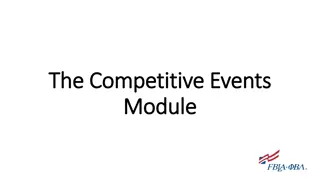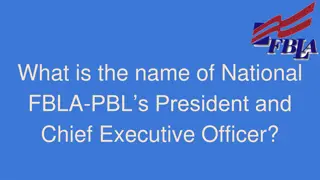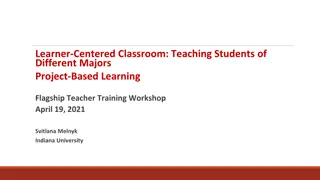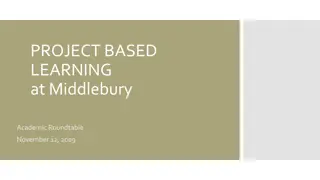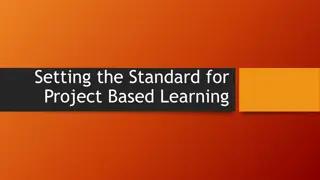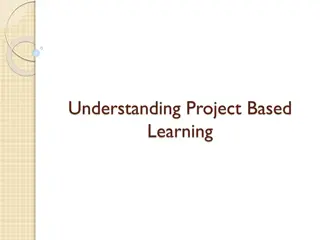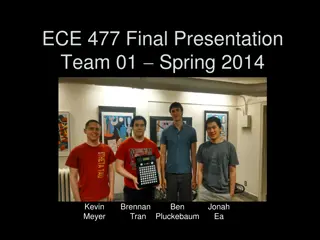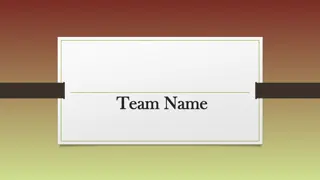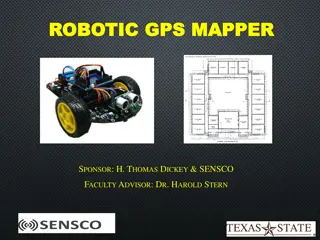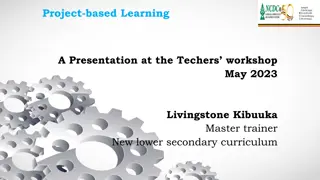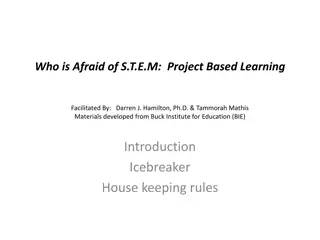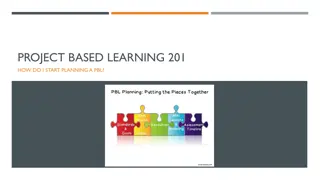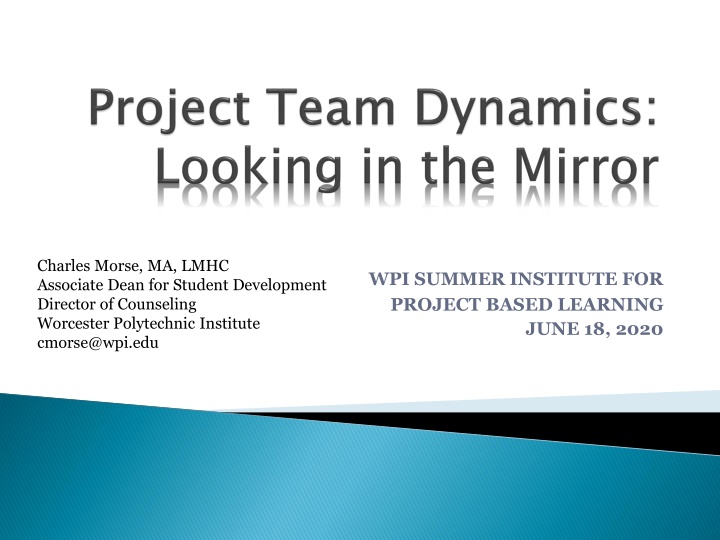
Enhancing Team Dynamics and Communication Strategies Through Interactive Exercises
Explore various exercises and strategies to improve team dynamics and communication within groups. Topics include dealing with differences, fostering engagement, utilizing the Myers-Briggs Type Indicator, and enhancing group performance through stages of development. Embrace the theme of differences as a valuable asset while learning how to navigate conflict for improved functioning.
Download Presentation

Please find below an Image/Link to download the presentation.
The content on the website is provided AS IS for your information and personal use only. It may not be sold, licensed, or shared on other websites without obtaining consent from the author. If you encounter any issues during the download, it is possible that the publisher has removed the file from their server.
You are allowed to download the files provided on this website for personal or commercial use, subject to the condition that they are used lawfully. All files are the property of their respective owners.
The content on the website is provided AS IS for your information and personal use only. It may not be sold, licensed, or shared on other websites without obtaining consent from the author.
E N D
Presentation Transcript
Charles Morse, MA, LMHC Associate Dean for Student Development Director of Counseling Worcester Polytechnic Institute cmorse@wpi.edu WPI SUMMER INSTITUTE FOR PROJECT BASED LEARNING JUNE 18, 2020
A few exercises which will help you reflect on your team dynamics Highlight the theme of differences as a source of tension within groups, but also a group s greatest asset Avoidance of tension/conflict is the most common factor in breakdown of group functioning
Willingness to engage Willingness of many to share video. Willingness of some to periodically Unmute when asked (and respond). Willingness of others to use chat function Have some fun while learning
Forming Storming Norming Performing Adjourning Synergy
Myers Briggs Type Indicator (MBTI) What is it? What it is not. The four MBTI personality dimensions I/E Introversion/Extroversion (Attention) S/N Sensing/Intuiting (Observation) T/F Thinking/Feeling (Decision Making) P/J Perceiving/Judging (relationship with time)
I/E test Link What does it mean? P/J test Link What does it mean?
I = 1.When you are with a group of people, would you usually rather: join in the talk of the group - E E = talk individually with people you know well - I 2. In a large group do you more often: introduce others - E get introduced - I 3. Would you say it generally takes others: a lot of time to get to know you - I a little time to get to know you - E 4. Do you spend a lot of time: by yourself - I with others - E 5. Can you: talk easily to almost anyone for as long as you have to - E find a lot to say only to certain people or under certain conditions - I
6. Can the new people you meet tell what you are interested in: right away - E only after they really get to know you - I 7. Would most people say you are: a private person - I a very open person - E 8. Do you find being around a lot of people: gives you more energy - E is often draining - I 9. Do you usually: mingle well with others - E tend to keep more to yourself - I 10. At parties do you: do much of the talking - E let others do most of the talking - I
1.Would you say you are more: easy going - P serious and determined - J 2. In most situations you are more: deliberate than spontaneous - J spontaneous than deliberate - P 3. Are you more: organized and orderly - J flexible and adaptable - P 4. Do you tend to notice: disorderliness - J opportunities for change - P 5. On the job do you want your activities: unscheduled - P scheduled - J
6. Is clutter in the workplace something you: tolerate pretty well - P take time to straighten up - J 7. Is it preferable mostly to: just let things happen naturally - P make sure things are arranged - J 8. Do you prefer to work: just whenever - P to deadlines - J 9. Do you tend to be more: regulated and structured - J easygoing, live and let live - P 10. Do you usually want things: settled and decided - J just penciled in - P
Talk about your I/E and P/J types and how they might be affecting team dynamics now or in the future? If your group is over-represented in one aspect or the other, how might this affect team functioning? Potential blind spots?
Which of the following best describes how you handle conflicts? 1.I don t like conflicts, and I try to avoid them. I would rather not be forced into a situation where I feel uncomfortable or under stress. When I do find myself in that kind of situation, I say very little, and I leave as soon as possible. 2.To me, conflicts are challenging. They re like contests or competitions opportunities for me to come with solutions. I can usually figure out what needs to be done, and I m usually right. 3.I try to see conflicts from both sides. What do I need? What does the other person need? What are the issues involved? I gather as much information as I can, and I keep the lines of communication open. I look for a solution that meets everyone s needs. 4.When faced with a conflict or even a potential conflict, I tend to back down or give in rather than cause problems. I may not get what I want, but that s a price I m willing to pay for keeping the peace. 5.I want to resolve the conflict as quickly as possible. I give up something I want or need, and I expect the other person to do the same. Then we can both move forward.
If you chose #1, your conflict resolution style is evader. This is a lose-lose strategy. When one partner avoids a conflict, neither partner has an opportunity to resolve it. Both partners lose. If you chose #2, your conflict resolution style is fighter. This is a win-lose/lose-win strategy. Either you win and your partner loses, or you lose and your partner wins. It s survival of the fittest. But conflicts are not contests, and this style precludes the possibility of finding a fair solution. If you chose #3, your conflict resolution style is negotiator. This is a win-win strategy. Both you and your partner have the chance to express your needs and resolve the conflict in a mutually acceptable way. While this strategy may sound simple, it s actually the most difficult to use. It requires each of you to articulate, prioritize, and satisfy your own needs while also addressing the other person s needs. If you chose #4, your conflict resolution style is harmonizer. This is a lose-win strategy. You lose because your needs aren t met. Your partner s needs are met, but the partnership suffers because you eventually become resentful and unsatisfied. If you chose #5, your conflict resolution style is compromiser. This is a lose-lose strategy. Both you and your partner give up something you need just to make the conflict go away. Invariably, you end up addressing the same issues later.
From Joanna Wolf Team Writing: a guide to working in groups pg. 54
Our minds tend to react to differences as wrong and/or bad Our minds aren t always our best asset Diversity can be seen through a lens of how we relate to differences Accept, Allow, Make room for (passive) vs. Invite, Embrace, Curiosity (active)
Truly embracing differences will be messy, uncomfortable Differences also provide the fuel which drives Synergy Synergy requires psychological safety The ability to read and react to other people in the group (social sensitivity) Equal opportunity to participate in the group
Charlie Morse Associate Dean/Director of Counseling cmorse@wpi.edu



